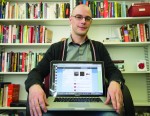Soulful vocals filled the lecture hall as the song “Crazy Blues” boomed from Professor Jerome Camal’s Spotify playlist. Bright laptop screens lit up the room as a tweet from the ethnomusicology professor appeared on his students’ Twitter newsfeeds: “I’ve got the early-morning-class blues.”
Instead of asking students to silence their cell phones and close the tabs on their Internet browsers, Camal is incorporating social media into his course, Music History 5: The History of Rock and Roll, this quarter.
Camal is in his second year of teaching at UCLA after earning his Ph.D. from Washington University in St. Louis in 2011. He taught the same class last year and said he regrets not using Twitter or Spotify.
“Large lectures can be very impersonal. When I taught the class last year, I didn’t know anyone because I had very little interaction with students,” he said.
Camal said his decision to use Twitter for his class stemmed from the realization that nearly every student has some sort of laptop or tablet open during class anyway.
While many students use these tools to take notes during lecture, he knows some of them also visit Facebook or text their friends.
“(Professors have) lost that battle,” he said.
Camal said he thinks it would be a waste of time to have his teaching assistants patrol the lecture and ask students to put away their phones. Rather than avoid the technology, he decided to embrace it.
“We’re trying to figure out how we can best integrate the tools students use outside the classroom into our classrooms,” he said.
In a large lecture hall with an enrollment of 360 students, it is often difficult for students to hear their peers’ questions. Asking questions in lecture via Twitter is simply more practical, Camal said. It also provides an alternative for students who may feel intimidated asking their questions out loud in a large lecture hall, he added.
Camal’s TAs have also adapted to the use of social media in the course.
During Monday’s lectures, they used tweets to comment on and highlight the main points of the lecture. Several TAs also acted as monitors, receiving the tweets at a computer at the front of the room and relaying the questions to Camal without disrupting the flow of the lecture.
Students are not required to bring a laptop to class or have a Twitter account. Students without an account can view the posts and find the feed through the class webpage.
Michael Aguilar, a graduate student in Latin American studies and a TA for the course, said he had never used Twitter or Spotify before the course but has learned how to use the media fairly quickly.
“From what I imagine, it has the potential to take a lot of work off of the TAs,” he said. Instead of answering the same question numerous times via email, Camal said he and his TAs can address student concerns more efficiently.
Quincy Vien, a second-year business economics student, said he thinks Twitter acts as a better discussion forum than the usual Common Collaboration & Learning Environment class website because students can benefit from each others’ questions in a more effective way.
While Twitter may be easier for contacting the class as a whole, Vien still prefers other modes of communication for specific concerns.
“Meeting in person or using email is still better for individual attention,” he said.
Other UCLA professors are also incorporating social media into their teaching.
Tobias Higbie, a history professor, experimented with Twitter in a history capstone seminar last spring. Like Camal, Higbie said he used Twitter to enhance discussion and spark debate.
Students who enrolled in his History 191 capstone seminar, “History, Now!” were required to tweet about their readings at least three times a week Higbie said.
“The limited number of characters in a Twitter post is a form of writing discipline,” he said. “I like students to try to express themselves in this tiny amount of space before expanding it into a fully elaborated piece of thought.”
The next time he uses Twitter for a course, Higbie plans to combine it with other resources, like the CCLE page.
“Ultimately, Twitter is not a replacement. I think it’s more of a supplement,” he said.
Though it is only the second week, Camal said he already feels more connected to his students. When they subscribe to his playlist on Spotify, he can click on their name and see what type of music they listen to. “It gives me a much better profile of who is in the class,” he said.
When he taught the class last year, the music samples he discussed in lectures weren’t easily accessible to students at home.
Spotify has helped expand the education outside of the classroom, Camal said. If a student likes a particular song they can click on it and access the rest of the artist’s output or start a radio selection based on that particular recording, Camal said.
“There are a lot of songs I’ve never even heard of. If I had to look them up on YouTube or something it’d be hard to know if I had the right version. With Spotify, I know I have the right song,” said Mariana Fernandez, a second-year English student who is enrolled in Camal’s course this quarter.
The Spotify playlists and Twitter account (@UCLAMusHst5) are both public. Camal said the Twitter account has amassed 160 followers, some unaffiliated with UCLA.
“I am not simply using Twitter because it is the cool, hip thing to do – it is an education tool that has the potential to strongly enhance student learning,” he said. “When students tweet a question or comment in lecture, they are engaged – thinking about something that was presented to them and then doing something about it.”
Email Beck at mbeck@media.ucla.edu.
